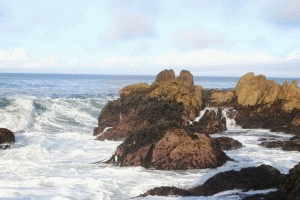 The intertidal zone of wave-swept rocky shores is one of the most physically stressful habitats on Earth. At low tide, marine organisms are faced with terrestrial conditions (e.g., heat and dessication stresses). At high tide, organisms are pummeled by breaking waves that can apply drag forces far greater than hurricane winds. We are particularly interested in intertidal seaweeds, which must survive these conditions wherever they settle and grow. (rollover image…)
The intertidal zone of wave-swept rocky shores is one of the most physically stressful habitats on Earth. At low tide, marine organisms are faced with terrestrial conditions (e.g., heat and dessication stresses). At high tide, organisms are pummeled by breaking waves that can apply drag forces far greater than hurricane winds. We are particularly interested in intertidal seaweeds, which must survive these conditions wherever they settle and grow. (rollover image…)
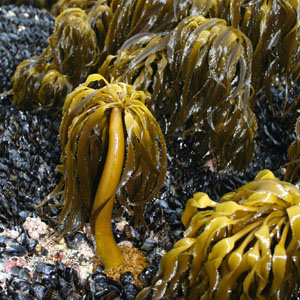
Selective pressures that drive diversity
The morphological diversity of marine macroalgae provides a constant source of questions. We are curious about the differential performance of seaweeds in flow and the selective pressures that shape modern diversity. Using re-circulating flumes, a high-speed water cannon, and various implements of algal torture, we compare drag and reconfiguration of intertidal fronds to forces required to break support tissues and predict hydrodynamic constraints on size, shape, and survival of seaweeds in the field.
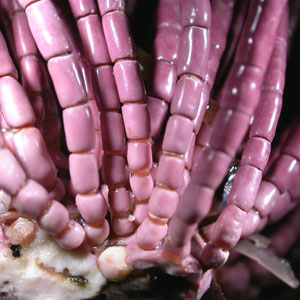
Convergent evolution of articulated algae
One common feature of intertidal seaweeds is flexibility. By being flexible, algae “go with the flow,” thereby reducing the drag on their thalli. This paradigm holds even for some calcified algae, which grow elaborate fronds by interspersing calcified segments with flexible joints. Articulated algae have evolved several times throughout evolutionary history – three times within the corallines alone. We have been studying the morphology, mechanical properties, development, and cell wall composition of joints (genicula) in coralline algae to explore their adaptation to hydrodynamic stress and the precision of their convergent evolution. We have found that genicular tissue is far stronger than other algal tissues and that basal genicula are morphologically well-adapted to resisting bending stresses, helping to explain how articulated corallines manage to dominate wave-swept coastlines around the world.
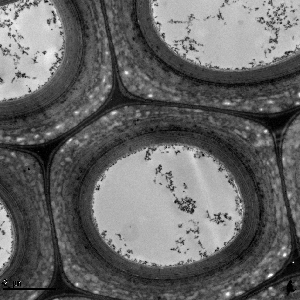
Early evolution of lignified cell walls
In our exploration of coralline genicula, we have discovered the presence of lignin and secondary cell walls, two features thought to have evolved when green algae took to land and, until now, had never been described in algae. Finding these characters in a red alga suggests that, contrary to the current paradigm, some of the biosynthetic pathways may have evolved in a common ancestor to reds and greens more than 1 billion years ago. We are in the process of searching for conserved genes using cDNA data. The cells that experience the greatest bending stresses under breaking waves contain the most lignin and the thickest secondary walls, suggesting some mechanically stimulated upregulation. However, the presence of lignin within calcified cellwalls suggests that the molecule may have originally evolved for some function other than mechanical support.
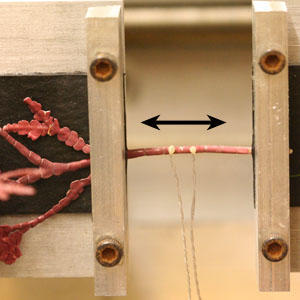
Biomaterials and cell wall mechanics
We are curious about the influence of cell wall chemistry and ultrastructure on the material properties of biological tissues. We have linked the strengthening of genicular tissue to an increase of cellulose within the cellwall, and data suggest that the addition of secondary walls stiffens genicular tissue and increases material toughness (i.e., energy to rupture). We plan to conduct serial chemical extractions on algal cellwalls to measure the contribution of individual cell wall constituents to mechanical performance, and plan to use birefringence techniques to link stress-strain curves to the reorientation of cellulose microfibrils within red algal cellwalls.
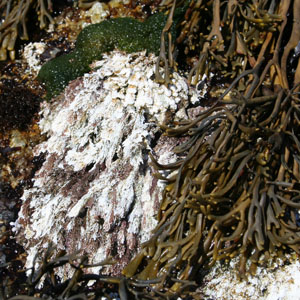
Bleaching and consequences of climate change
Coralline algae are central components of marine ecosystems. They cement coral reefs together, form habitat for other plants and animals, and produce cues to stimulate settlement of many invertebrates. Loss of coralline algae would likely have cascading effects throughout marine communities. We are interested in the effects of climate change (e.g., pH decline, temperature increase) on coralline algal growth and physiology. Intertidal coralline algae are susceptible to “bleaching” when the tide is out and the weather is hot and sunny. Data suggest that temperature, dessication, and light intensity can all induce bleaching, but they are particularly harmful when combined. These data can be used in climate models to predict hypothetical impacts on coralline populations and on the communities that depend upon them.
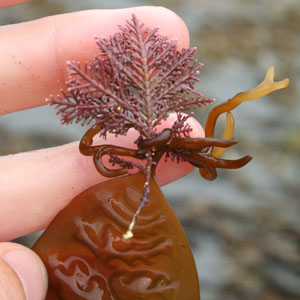
Life history strategies in the intertidal zone
The wave-swept intertidal zone is a stressful place to live. Algae are often ripped from the substratum by crashing waves. We’ve demonstrated that articulated coralline fronds can persist for months after being separated from their crustose base and, if conditions are right, the meristems of severed fronds can re-attach to the substratum and grow new upright fronds. Thus, breakage may not always be bad. Another physical constraint is space; with limited open space for spores to settle, many algae epiphytize other seaweeds. Data on epiphytized algae suggest that such a relationship often spells disaster for the host, as both plants grow and drag on the system increases. What is the reproductive cost incurred by coralline hosts, as fleshy epiphytes grow quickly, reproduce, and cause the pair to break? Do epiphytes gain some mechanical advantage from growing on other plants?